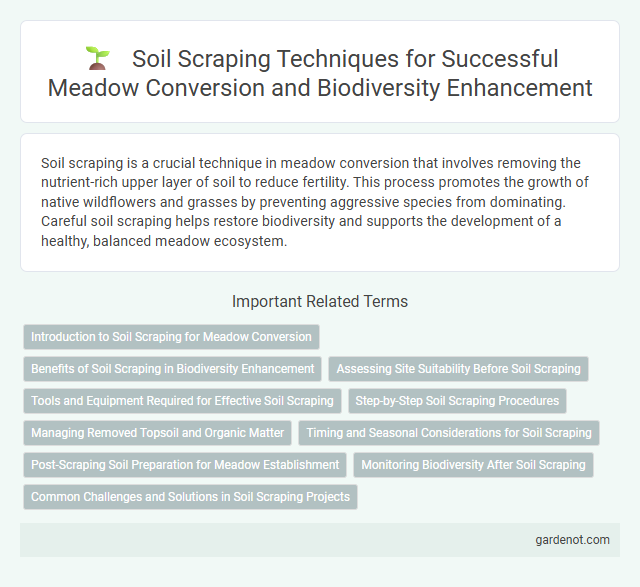Soil scraping is a crucial technique in meadow conversion that involves removing the nutrient-rich upper layer of soil to reduce fertility. This process promotes the growth of native wildflowers and grasses by preventing aggressive species from dominating. Careful soil scraping helps restore biodiversity and supports the development of a healthy, balanced meadow ecosystem.
Introduction to Soil Scraping for Meadow Conversion
Soil scraping is a crucial technique in meadow conversion that involves removing the nutrient-rich top layer of soil to reduce fertility and encourage the growth of native meadow plants. This process helps restore natural biodiversity by creating conditions favorable for wildflowers, grasses, and other meadow species that thrive in low-nutrient environments. Implementing soil scraping effectively controls invasive species and promotes the establishment of diverse plant communities essential for a healthy meadow ecosystem.
Benefits of Soil Scraping in Biodiversity Enhancement
Soil scraping removes nutrient-rich topsoil, reducing dominant plant species and allowing diverse native flora to establish, which increases habitat heterogeneity. This process helps restore natural soil conditions by eliminating invasive species seeds and encourages the resurgence of rare and specialized plants. Enhanced plant diversity resulting from soil scraping supports a wider range of pollinators, insects, and other wildlife, promoting overall ecosystem resilience.
Assessing Site Suitability Before Soil Scraping
Assessing site suitability before soil scraping involves evaluating soil composition, moisture levels, and existing vegetation to ensure minimal ecological disruption during meadow conversion. Soil tests measuring pH, nutrient content, and compaction inform the potential success of soil scraping and its impact on native plant establishment. Identifying slope gradients and water drainage patterns prevents erosion and maintains soil stability throughout the restoration process.
Tools and Equipment Required for Effective Soil Scraping
Effective soil scraping in meadow conversion requires specialized tools such as heavy-duty scrapers, bulldozers, and skid-steer loaders equipped with grading blades to remove topsoil precisely. Additionally, laser-guided leveling systems enhance accuracy by ensuring consistent soil removal, promoting optimal seedbed preparation. Proper maintenance of equipment, including sharp blades and calibrated machinery, is essential to achieve uniform soil depth and improve overall soil structure for successful meadow restoration.
Step-by-Step Soil Scraping Procedures
Begin soil scraping by clearing the area of vegetation and debris to expose the topsoil layer. Use heavy machinery such as bulldozers or scrapers to carefully remove the upper soil layer, ensuring minimal disturbance to the underlying subsoil. Collect and transport the scraped soil for replacement or processing, preparing the site for subsequent meadow conversion activities.
Managing Removed Topsoil and Organic Matter
Managing removed topsoil and organic matter during meadow conversion is crucial for preserving soil fertility and structure. Carefully stockpiling topsoil separately allows for its nutrient-rich properties to be retained and reapplied to support new vegetation growth. Incorporating organic matter back into the soil enhances microbial activity and improves moisture retention, promoting a healthy, sustainable meadow ecosystem.
Timing and Seasonal Considerations for Soil Scraping
Optimal timing for soil scraping in meadow conversion occurs during dry seasons, typically late summer to early fall, to prevent soil compaction and facilitate easier debris removal. Seasonal considerations are crucial as wet conditions can hinder equipment access and damage soil structure, impacting future plant growth. Undertaking soil scraping during dormancy periods minimizes disruption to native flora and allows for a more sustainable restoration process.
Post-Scraping Soil Preparation for Meadow Establishment
Post-scraping soil preparation for meadow establishment involves leveling the soil surface to ensure uniform seedbed conditions and improve water infiltration. Incorporating organic matter enhances soil structure and nutrient availability, promoting healthy root development for native meadow species. Properly prepared soil after scraping reduces weed competition and supports successful meadow plant germination and growth.
Monitoring Biodiversity After Soil Scraping
Monitoring biodiversity after soil scraping in meadow conversion is essential to assess recovery and ecosystem health. Regular surveys of plant species composition and abundance provide critical data on native flora regeneration and invasive species control. Tracking soil invertebrates and microbial communities offers insights into soil quality and functional diversity, guiding adaptive management strategies.
Common Challenges and Solutions in Soil Scraping Projects
Soil scraping in meadow conversion often faces challenges such as uneven soil depth, compaction, and loss of native seed banks, which can hinder successful vegetation establishment. Solutions include precise depth control using GPS-guided machinery, amelioration of compacted layers through subsoiling, and strategic stockpiling of topsoil to preserve viable seeds for re-spreading. Implementing these techniques enhances soil structure and promotes biodiversity restoration in converted meadow landscapes.
Soil scraping Infographic

 gardenot.com
gardenot.com